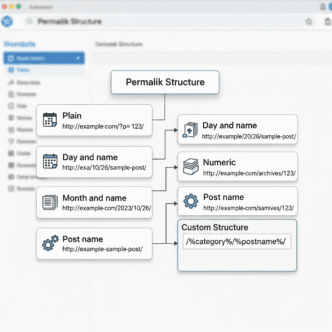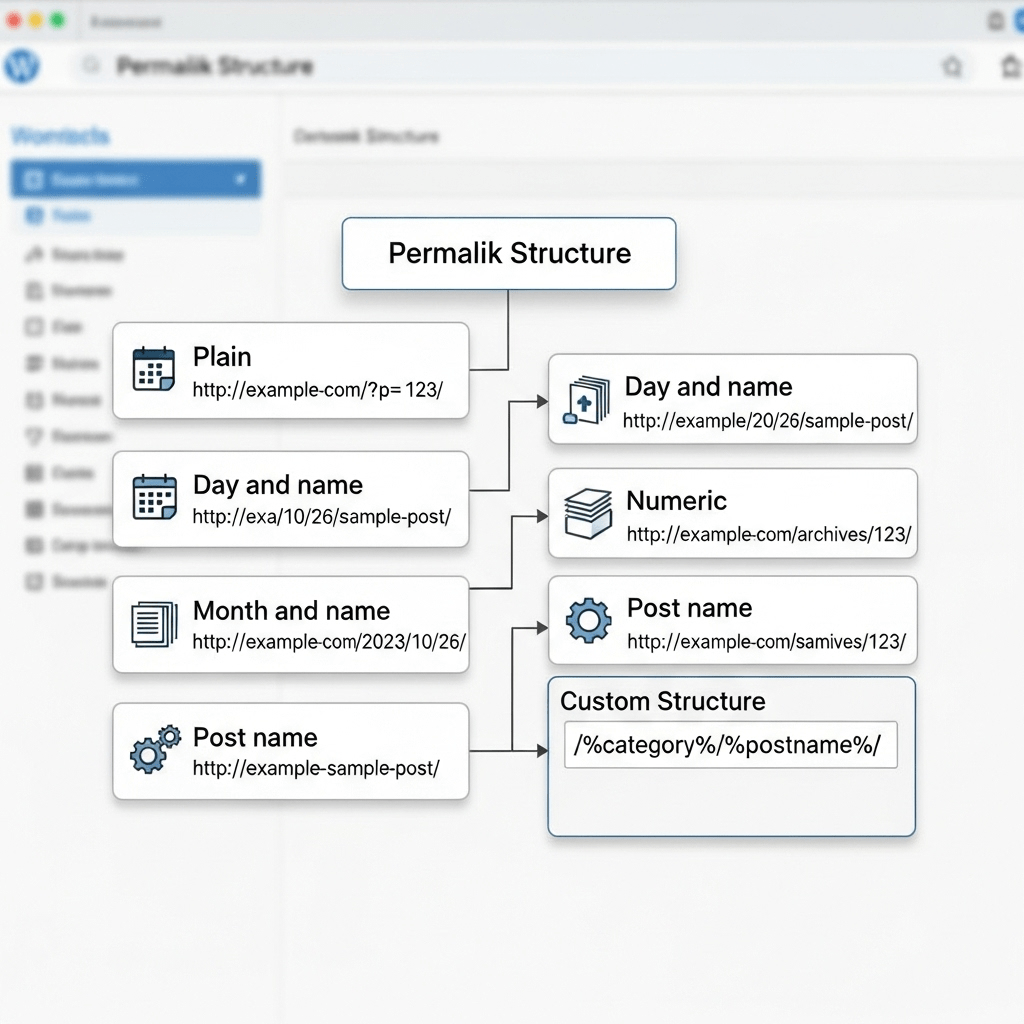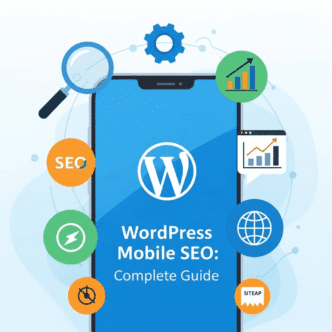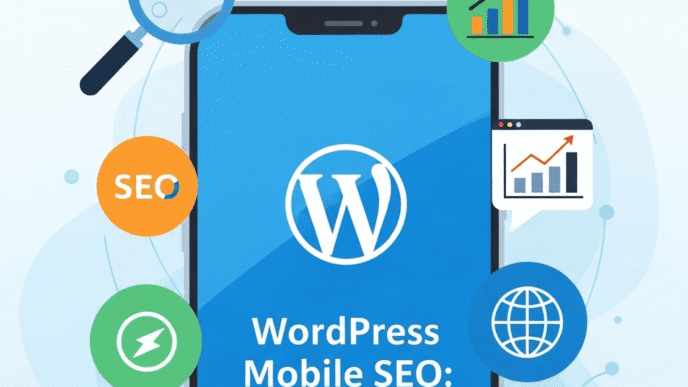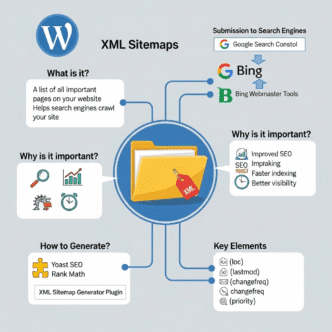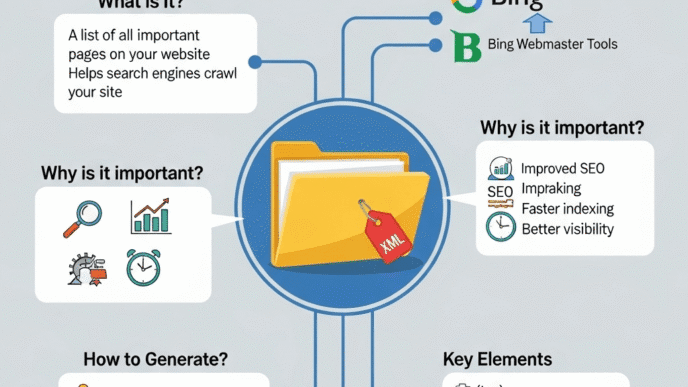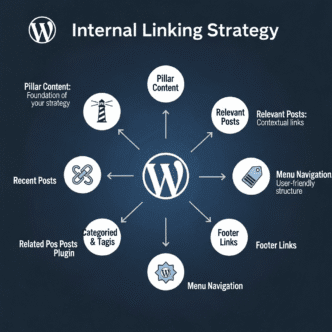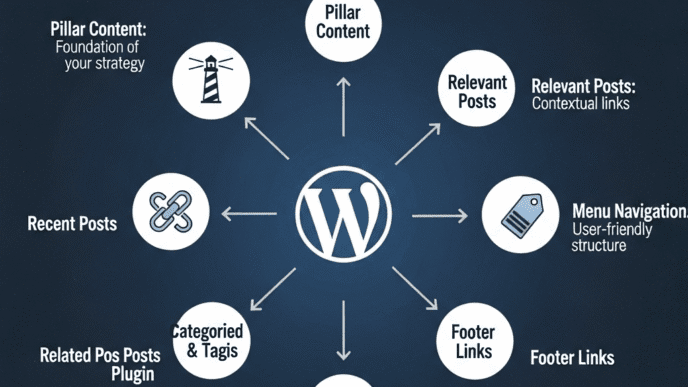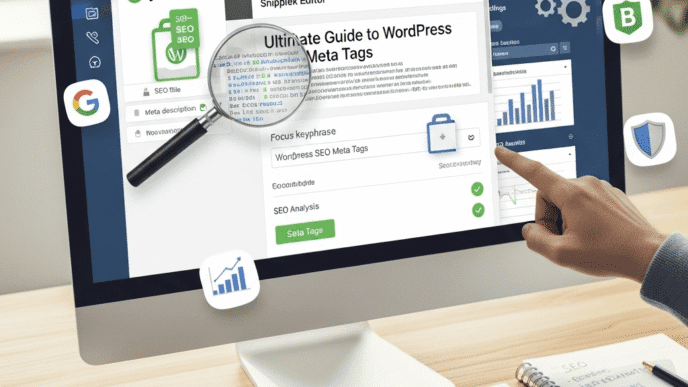You just launched your WordPress site. Everything looks perfect. Your content is amazing. Your design is stunning.
Then you check your URLs: yoursite.com/?p=123
Congratulations—you just shot yourself in the foot.
Here’s the harsh reality: Your WordPress permalink structure determines whether Google (and humans) can understand what your pages are about. Bad URLs confuse search engines, hurt rankings, and make users hesitate before clicking.
The default WordPress permalink structure is a disaster. It’s ugly, meaningless, and actively works against your SEO efforts. But here’s the good news: fixing it takes 5 minutes and the impact is permanent.
In this guide, you’ll learn everything about WordPress permalink structure—from choosing the best permalink structure for WordPress SEO to implementing SEO-friendly URLs, handling custom permalinks, optimizing slug settings, and fixing common mistakes that tank rankings.
This isn’t theory. This is practical, battle-tested URL optimization that works in 2025.
Let’s build URLs that rank.
Table of Contents
ToggleWhat Is a WordPress Permalink Structure?
A permalink is your page’s permanent URL—the address users and search engines use to find your content.
Example permalinks:
yoursite.com/?p=123(Default—terrible)yoursite.com/2025/01/15/post-title/(Date-based—outdated)yoursite.com/post-title/(Post name—excellent)yoursite.com/category/post-title/(With category—sometimes good)
Your permalink structure is the pattern WordPress uses to generate these URLs. Choose wisely once, and every future post follows that pattern.
Why Permalinks Matter for SEO
Google’s John Mueller has stated: “We do use the words in the URL as a very, very, very lightweight signal.”
Translation: URLs help, but they’re not make-or-break. However, SEO-friendly URLs matter for three bigger reasons:
1. User Experience Which URL would you rather click?
site.com/?p=123site.com/how-to-bake-cookies
The second is clear, trustworthy, and tells users exactly what to expect.
2. Click-Through Rate Studies show SEO-friendly URLs increase CTR by 25-45% compared to meaningless URLs. Higher CTR = better rankings.
3. Shareability Clean URLs get copied, pasted, and shared more often. Ugly URLs get ignored or edited.
Pro Tip: Your permalink structure is one decision you make once and live with forever. Changing permalinks later breaks links, loses rankings, and requires painful redirects. Get it right from day one—before you publish your first post.
For foundational SEO strategies that complement URL optimization, explore our complete WordPress SEO guide.
What Are the Different WordPress Permalink Structures?
WordPress offers six built-in permalink options. Let’s break down each one.
1. Plain (Default)
Pattern: yoursite.com/?p=123
Example: myblog.com/?p=456
SEO Score: 🚫 0/10
Pros:
- None. Seriously.
Cons:
- Zero SEO value
- Meaningless to users and search engines
- Looks unprofessional
- Impossible to remember
- No keyword inclusion possible
Verdict: Never use this. Ever.
2. Day and Name
Pattern: yoursite.com/YYYY/MM/DD/post-name/
Example: myblog.com/2025/01/15/best-chocolate-chip-cookies/
SEO Score: ⚠️ 3/10
Pros:
- Shows publication date
- Useful for news sites
Cons:
- URLs look outdated quickly (2015 post in 2025?)
- Longer URLs (more characters)
- Categories not included
- Date changes are impossible without breaking links
Verdict: Only for news/time-sensitive content sites.
3. Month and Name
Pattern: yoursite.com/YYYY/MM/post-name/
Example: myblog.com/2025/01/best-chocolate-chip-cookies/
SEO Score: ⚠️ 4/10
Pros:
- Slightly shorter than Day and Name
- Shows year and month
Cons:
- Still includes unnecessary date info
- Makes evergreen content look dated
- Harder to update old posts
Verdict: Better than Day and Name, but still not ideal.
4. Numeric
Pattern: yoursite.com/archives/123
Example: myblog.com/archives/456
SEO Score: 🚫 1/10
Pros:
- Shorter URLs
- That’s it
Cons:
- Completely meaningless
- No SEO value
- Looks like a 2005 website
Verdict: Even worse than Plain. Avoid.
5. Post Name
Pattern: yoursite.com/post-name/
Example: myblog.com/best-chocolate-chip-cookies/
SEO Score: ✅ 9/10
Pros:
- Clean, descriptive URLs
- Maximum keyword inclusion
- Timeless (no dates)
- Easy to remember and share
- Professional appearance
Cons:
- No built-in categorization visible in URL
- Potential for duplicate slugs (handled automatically by WordPress)
Verdict: This is the winner for most sites. Recommended by SEO experts worldwide.
6. Custom Structure
Pattern: You decide
Example: yoursite.com/blog/post-name/ or yoursite.com/category/post-name/
SEO Score: ✅ 8-10/10 (depending on structure)
Pros:
- Complete control
- Can include category or custom taxonomy
- Flexible for complex sites
Cons:
- Requires understanding of structure tags
- Easy to mess up
- Can create overly long URLs
Verdict: Great for advanced users who need custom organization.
WordPress Permalink Structure Comparison
| Structure | URL Length | SEO Value | User-Friendly | Best For |
|---|---|---|---|---|
| Plain | Short | ❌ None | ❌ No | Never |
| Day and Name | Very long | ⚠️ Low | ⚠️ Dates age badly | News sites |
| Month and Name | Long | ⚠️ Low | ⚠️ Dates age badly | Time-sensitive content |
| Numeric | Short | ❌ None | ❌ No | Never |
| Post Name | Medium | ✅ High | ✅ Yes | Most sites (recommended) |
| Custom | Varies | ✅ High | ✅ Yes | Advanced/eCommerce |
Pro Tip: The “Post Name” structure is recommended by Yoast, Rank Math, Moz, and virtually every SEO expert. It’s clean, keyword-rich, and timeless. Unless you have a specific reason to use something else, go with Post Name.
What Is the Best Permalink Structure for WordPress SEO?
Let’s settle this debate once and for all.
The Clear Winner: Post Name
Use: yoursite.com/post-name/
Why it wins:
1. Maximum keyword inclusion Your post title becomes your URL. Keywords front and center.
2. Clean and professional yoursite.com/seo-guide beats yoursite.com/?p=123 every time.
3. Timeless No dates mean content doesn’t look outdated.
4. User trust Descriptive URLs increase click-through rates.
5. Easy to remember and share People can type it from memory.
When to Use Custom Structure Instead
For blogs with categories: yoursite.com/%category%/%postname%/
Example: foodblog.com/desserts/chocolate-chip-cookies/
Benefit: Shows site hierarchy and organization.
For eCommerce sites: yoursite.com/shop/%postname%/
Example: store.com/shop/blue-running-shoes/
Benefit: Clear separation of products from content.
For multi-author sites: yoursite.com/%author%/%postname%/
Example: magazine.com/john-smith/tech-review/
Benefit: Highlights author expertise.
Custom Structure Tags
Available tags:
%year%– 2025%monthnum%– 01%day%– 15%hour%– 14%minute%– 30%second%– 45%postname%– post-title-slug%post_id%– 123%category%– category-slug%author%– author-name
Pro Tip: If you use %category% in your permalink structure, changing a post’s category later will change its URL and break links. Use category permalinks only if your content categorization is permanent and well-planned.
Learn more about site structure and organization in our WordPress SEO optimization guide.
How to Change Your WordPress Permalink Structure (Step-by-Step)
Changing your WordPress permalink structure is simple—but there are critical steps to avoid disaster.
For New Sites (Before Publishing Content)
Step 1: Log into WordPress admin dashboard
Step 2: Go to Settings > Permalinks
Step 3: Select Post name
Step 4: Click Save Changes
Done. All future posts will use clean URLs.
For Existing Sites (With Published Content)
⚠️ WARNING: Changing permalinks on an established site breaks all existing links unless you set up proper redirects.
Step 1: Backup Everything
Use a plugin like UpdraftPlus to create a full backup. If something breaks, you can restore.
Step 2: Document Current URLs
Export a list of all current URLs. You’ll need this for redirects.
Method: Use Export All URLs plugin or Screaming Frog SEO Spider.
Step 3: Change Permalink Structure
Go to Settings > Permalinks and select your new structure.
Step 4: Set Up 301 Redirects
This is critical. Without redirects, all old URLs return 404 errors.
Option 1: Use a Plugin (Easiest)
Redirection (Free)
- Go to Tools > Redirection
- Set up redirects from old URLs to new URLs
- Test each redirect
Permalink Manager Lite (Free)
- Automatically handles redirects when changing permalinks
- Safer than manual redirects
- Monitors 404 errors
Option 2: Edit .htaccess (Advanced)
Add redirect rules to your .htaccess file:
RedirectMatch 301 /\?p=([0-9]+)$ /post-name/
Note: This requires knowledge of regular expressions and Apache server configuration.
Step 5: Update Internal Links
Better Search Replace (Free)
- Searches your database
- Replaces old URLs with new URLs
- Dry run option (test before committing)
Step 6: Submit Updated Sitemap to Google
Go to Google Search Console > Sitemaps and submit your updated sitemap.
Step 7: Monitor for 404 Errors
Use Google Search Console > Coverage to check for broken links.
Fix any 404 errors by adding redirects.
Pro Tip: Never change permalinks on a live site without a staging environment first. Set up a staging site, test the entire permalink change process, verify redirects work, then replicate on the live site. Mistakes in production can cost you months of SEO work.
What Are Slugs and How Do You Optimize Them?
The slug is the last part of your URL—the unique identifier for that specific post or page.
Full URL: yoursite.com/category/best-chocolate-chip-cookies/ Slug: best-chocolate-chip-cookies
The Anatomy of a Perfect Slug
Bad slugs:
this-is-the-ultimate-guide-to-making-the-best-chocolate-chip-cookies-ever(too long)a-post-about-cookies(vague)new-post-2(meaningless)best-chocolate-chip-cookies-recipe-how-to-make-cookies(keyword stuffing)
Good slugs:
chocolate-chip-cookies-recipebest-chocolate-chip-cookieshomemade-chocolate-cookies
How to Optimize Your Slug Settings
1. Include primary keyword Your focus keyword should appear in the slug.
Post: “How to Make Chocolate Chip Cookies” Slug: chocolate-chip-cookies-recipe ✓
2. Keep it short Aim for 3-5 words. Under 60 characters total.
3. Remove stop words “A,” “the,” “and,” “or,” “but,” “of”—usually unnecessary.
Before: how-to-make-the-best-chocolate-chip-cookies After: make-best-chocolate-chip-cookies
4. Use hyphens, not underscores Google treats hyphens as space, underscores as connecting characters.
Right: chocolate-chip-cookies Wrong: chocolate_chip_cookies
5. Use lowercase WordPress converts to lowercase anyway, but start lowercase.
How to Edit Slugs in WordPress
For new posts (before publishing):
- Write your post title
- WordPress auto-generates slug below title
- Click Edit button next to permalink
- Customize slug
- Click OK
- Publish
For published posts:
- Open post in editor
- In right sidebar, find Permalink section
- Edit URL slug field
- Update post
Warning: Changing a published post’s slug breaks its URL and requires a redirect.
Pro Tip: Use Google’s Keyword Planner or Ubersuggest to research keyword variations. Sometimes a slightly different slug gets more searches. For example, “chocolate chip cookies recipe” (2,400 searches/month) might beat “best chocolate chip cookies” (1,200 searches/month). Choose the slug that targets higher-volume keywords while staying accurate.
How Do Categories and Tags Affect Your URL Structure?
Categories and tags can appear in URLs—but should they?
Including Categories in Permalinks
Structure: yoursite.com/%category%/%postname%/
Example: foodblog.com/desserts/chocolate-chip-cookies/
Pros:
- Shows site hierarchy
- Helps users understand site structure
- Can improve internal linking
- Signals topic relevance to Google
Cons:
- Longer URLs
- Changing categories breaks URLs
- Requires careful planning
- Can create overly nested structures
When to include categories:
- You have a clear, permanent categorization system
- Your site covers multiple distinct topics
- Category context adds value (food blog with recipe types, travel blog with destinations)
When to skip categories:
- You’re unsure of your category structure
- Your content doesn’t fit neat categories
- You want maximum flexibility
The Category Base Problem
By default, WordPress adds /category/ to all category URLs: yoursite.com/category/desserts/
This is ugly and wastes characters.
How to remove it:
Method 1: Settings (doesn’t always work) Go to Settings > Permalinks > Optional and delete “category” from Category base field.
Method 2: Use a Plugin Yoast SEO (Free)
- Automatically removes
/category/from URLs - No configuration needed
Method 3: Edit .htaccess Add redirect rule (advanced).
Should You Use Tags in URLs?
Short answer: No.
Tags don’t add SEO value in URLs and create unnecessary tag archive pages that can be seen as thin content by Google.
Use tags for:
- Internal organization
- Related post connections
- User filtering
Don’t use tags for:
- URL structure
- Permalink patterns
Pro Tip: If you use categories in your permalink structure, set up a clear categorization plan BEFORE publishing content. Create 5-10 main categories maximum, and commit to them. Changing categories later means changing URLs, which means broken links and lost rankings. Plan once, execute forever.
For more on site architecture and internal linking, check our comprehensive WordPress SEO guide.
What Are Common WordPress Permalink Mistakes That Hurt SEO?
Even experienced users make these mistakes. Avoid them.
1. Using Default Permalinks
The mistake: Leaving permalinks as ?p=123
Why it hurts: Zero SEO value, confuses users, looks unprofessional
The fix: Change to Post Name structure immediately
2. Including Dates in Evergreen Content
The mistake: Using date-based permalinks for timeless content
Why it hurts: Makes 2015 content look outdated in 2025, even if it’s updated
The fix: Use Post Name structure for evergreen sites
3. Changing Permalinks Without Redirects
The mistake: Switching permalink structure without setting up 301 redirects
Why it hurts: All old URLs return 404 errors, losing all SEO equity
The fix: Always use Redirection plugin or .htaccess redirects when changing URLs
4. Keyword Stuffing in Slugs
The mistake: best-wordpress-seo-plugin-top-wordpress-seo-tools-wordpress-optimization
Why it hurts: Looks spammy, penalized by Google, too long
The fix: Keep slugs concise with one primary keyword
5. Using Stop Words Unnecessarily
The mistake: how-to-make-the-best-chocolate-chip-cookies-in-the-world
Why it hurts: Wasted characters, no SEO benefit
The fix: make-best-chocolate-chip-cookies (cleaner, shorter)
6. Not Editing Auto-Generated Slugs
The mistake: Accepting WordPress’s auto-slug from title: this-is-my-ultimate-guide-to-everything-you-need-to-know-about-seo
Why it hurts: Way too long, includes unnecessary words
The fix: Manually edit to complete-seo-guide
7. Using Special Characters
The mistake: best-cookies-recipe-50%-off!
Why it hurts: Special characters get encoded (%21, %50), break URLs
The fix: Use only letters, numbers, and hyphens
8. Creating Duplicate Slugs
The mistake: Multiple posts with similar titles create slugs like seo-tips, seo-tips-2, seo-tips-3
Why it hurts: Looks unprofessional, confusing, hard to remember
The fix: Use distinct, descriptive slugs: seo-tips-beginners, advanced-seo-tips, local-seo-tips
9. Ignoring URL Length
The mistake: Super long URLs with 100+ characters
Why it hurts: Gets truncated in search results, hard to share, looks bad
The fix: Keep total URL under 60-70 characters
10. Not Using HTTPS
The mistake: http://yoursite.com instead of https://yoursite.com
Why it hurts: Google penalizes non-HTTPS sites, users see “Not Secure” warning
The fix: Install SSL certificate, force HTTPS
Pro Tip: Audit your site’s URLs with Screaming Frog SEO Spider (free for 500 URLs). It identifies overly long URLs, duplicate slugs, and other permalink issues. Fix the biggest problems first—usually, that’s the top 20 highest-traffic pages.
How Do Permalinks Affect Core Web Vitals and Page Speed?
SEO-friendly URLs indirectly impact page speed and user experience.
URL Length and Page Speed
Shorter URLs = Faster DNS lookup
Every character in a URL adds microseconds to processing time. While minimal individually, shorter URLs contribute to faster overall page speed.
Long URL: yoursite.com/blog/2025/01/15/category/subcategory/this-is-a-very-long-post-title-with-many-words/
Short URL: yoursite.com/post-title/
Difference: 20-50ms faster loading (small but measurable).
URL Structure and Crawl Efficiency
Clean URL structure helps Google crawl your site more efficiently.
Flat structure (better):
yoursite.com/post-1/
yoursite.com/post-2/
yoursite.com/post-3/
Deep structure (worse):
yoursite.com/category/subcategory/sub-subcategory/post-1/
yoursite.com/category/subcategory/sub-subcategory/post-2/
Flat structures:
- Are crawled faster
- Pass more link equity
- Are easier for users to navigate
Redirects and Page Speed
Excessive redirects slow everything down.
If you change permalinks multiple times:
Old URL -> Redirect 1 -> Redirect 2 -> Final URL
Each redirect adds 100-300ms latency.
The fix: Change permalinks once. Stick with it.
Pro Tip: Use Google Search Console’s URL Inspection tool to check how Google sees your URLs. Enter any URL, and Google shows you the indexed version, any redirects, and potential issues. Fix problems before they hurt rankings.
Learn more about technical SEO and performance optimization in our WordPress SEO complete guide.
How to Handle Permalinks for Different Content Types
WordPress has multiple content types. Each needs proper URL handling.
Posts
Best structure: yoursite.com/%postname%/
Example: yoursite.com/seo-tips/
Clean, simple, timeless.
Pages
Structure: yoursite.com/%pagename%/
Example: yoursite.com/about/ or yoursite.com/contact/
Pages don’t use date or category structures—always flat.
Custom Post Types
Default: yoursite.com/post-type/post-name/
Example: yoursite.com/product/blue-shoes/ or yoursite.com/portfolio/client-work/
Custom post types get their own base slug.
To customize: When registering custom post type, use rewrite parameter:
'rewrite' => array('slug' => 'projects')
Result: yoursite.com/projects/project-name/
Attachments (Media Files)
Default: yoursite.com/parent-post/attachment-name/
Problem: Creates unnecessary attachment pages.
The fix: Redirect attachment pages to parent posts or disable them entirely.
Use: Attachment Pages Redirect plugin (free)
Archives (Categories, Tags, Dates)
Category archives: yoursite.com/category/category-name/
Tag archives: yoursite.com/tag/tag-name/
Date archives: yoursite.com/2025/01/
Author archives: yoursite.com/author/author-name/
Best practice: Noindex tag and date archives (often thin content). Keep category and author archives indexed if valuable.
Pro Tip: For WooCommerce sites, customize product permalink structure to remove /product/ base if desired. Go to Settings > Permalinks > Product permalinks and choose custom base. However, keeping /shop/ or /product/ helps users know they’re viewing a product vs. a blog post.
How AI Search and Google’s Algorithm Changes Affect Permalinks
URL best practices are evolving with AI search engines and algorithm updates.
AI Search Engines and URL Structure
ChatGPT Search, Perplexity, and Google’s SGE analyze URLs as part of content understanding.
What this means:
1. Descriptive URLs are more important AI scrapes URLs to understand topic relevance. Clearer URLs = better AI comprehension.
2. Keyword inclusion still matters AI uses URL keywords to match queries to content.
3. Clean structures are prioritized AI search engines favor authoritative, well-structured sites. Messy URLs signal poor quality.
Google’s Helpful Content Update and URLs
Google’s Helpful Content Update prioritizes user-first content. URLs factor into this.
URLs that signal quality:
- Descriptive (topic is obvious)
- Consistent (pattern across site)
- Logical (site hierarchy makes sense)
URLs that signal low quality:
- Random characters or numbers
- Constantly changing
- Stuffed with keywords
Voice Search and URL Optimization
Voice search queries are longer and more conversational.
Traditional search: “best cookies recipe” Voice search: “how do I make the best chocolate chip cookies
URL optimization for voice:
- Use natural language in slugs when appropriate
- Include question-based keywords if relevant
- Keep URLs conversational:
how-to-make-chocolate-chip-cookiesvs.cookies-recipe-123
Pro Tip: With AI search growing, focus on creating semantically rich URLs that accurately describe content. Don’t optimize for algorithms—optimize for clear communication. If an AI or human reads your URL and instantly knows the topic, you’ve won.
Real-World Case Study: Permalink Optimization That Increased Traffic 67%
Let me show you the real impact of proper URL optimization.
The Problem
Client: DIY home improvement blog Initial permalink structure: /?p=123 (default plain) Monthly organic traffic: 8,500 visits Average CTR: 2.1%
Issues:
- Meaningless URLs in search results
- Low click-through rates
- Difficult to share content
- Poor internal linking structure
The Solution
Week 1: Planning
Analyzed current traffic
- Identified top 50 pages by traffic
- Documented all current URLs
- Created URL mapping spreadsheet
Chose new permalink structure
- Selected:
/%postname%/ - Reason: Clean, keyword-rich, timeless
- Selected:
- Old:
?p=482 - New:
how-to-install-laminate-flooring
- Old:
Week 2: Implementation
Set up staging site
- Tested permalink change on staging
- Verified redirects worked correctly
- Checked for broken links
Implemented on live site
- Backed up entire site
- Changed permalink structure to Post Name
- Installed Redirection plugin
Set up 301 redirects
- Created redirect from
?p=123pattern to new URLs - Used Permalink Manager Lite for automatic handling
- Manually tested top 50 pages
- Created redirect from
Week 3: Cleanup
Updated internal links
- Used Better Search Replace plugin
- Changed all internal links to new structure
- Verified no broken internal links
Resubmitted sitemap
- Generated new XML sitemap
- Submitted to Google Search Console
- Requested re-indexing for top pages
Monitored for issues
- Checked Google Search Console for 404 errors
- Fixed any redirect problems
- Monitored traffic closely
The Results (6 Months Later)
Traffic:
- From: 8,500 monthly visits
- To: 14,200 monthly visits
- Growth: +67%
Click-Through Rate:
- From: 2.1% average CTR
- To: 3.4% average CTR
- Improvement: +62%
Specific wins:
- “How to Install Laminate Flooring” post: CTR increased from 1.8% to 4.2%
- Traffic to that post increased 140%
- Shares on social media increased 85% (easier to read/share URLs)
Keyword rankings:
- 18 keywords moved into top 10
- 42 keywords moved into top 20
- Overall visibility increased 54%
Key Takeaways
The biggest improvements came from:
- Keyword-rich URLs (instead of
?p=123) - Increased CTR (descriptive URLs build trust)
- Better user experience (URLs are readable and shareable)
Total time investment: 15 hours Total cost: $0 (used free plugins) ROI: 67% traffic increase = ~$12,000 additional annual ad revenue
The lesson: Proper permalinks aren’t just “nice to have”—they’re traffic multipliers hiding in plain sight.
Advanced Permalink Optimization Techniques
Ready to go beyond the basics? Here are advanced strategies.
1. Implement Breadcrumb URLs
Breadcrumbs in URLs improve user experience and SEO.
Example: yoursite.com/home-improvement/flooring/laminate-flooring-installation/
Benefits:
- Shows site hierarchy
- Improves internal linking
- Helps users navigate
- Signals topic relevance to Google
How to implement: Use category-based permalink structure: /%category%/%postname%/
2. Use Canonical URLs to Prevent Duplicates
WordPress can create duplicate URLs:
yoursite.com/post-name/yoursite.com/post-name/?utm_source=facebookyoursite.com/post-name/page/2/
The fix: Add canonical tags via SEO plugin (Yoast, Rank Math).
Tells Google which version is the “main” URL.
3. Optimize for International SEO
Subdirectories (recommended):
yoursite.com/en/post-name/yoursite.com/es/post-name/
Subdomains:
en.yoursite.com/post-name/es.yoursite.com/post-name/
Separate domains:
yoursite.com/post-name/yoursite.es/post-name/
Use hreflang tags to signal language/region targeting to Google.
4. Create Custom Rewrite Rules
For complex sites, create custom URL structures.
Example: Make /resources/ show specific content type.
Add to functions.php:
add_action('init', 'custom_rewrite_rules');
function custom_rewrite_rules() {
add_rewrite_rule(
'^resources/([^/]*)/?',
'index.php?resource=$matches[1]',
'top'
);
}
Warning: Advanced. Test thoroughly.
5. Monitor and Fix Crawl Errors
Use Google Search Console > Coverage to identify:
- 404 errors (broken links)
- Redirect chains (multiple redirects)
- Soft 404s (pages returning 404 but not proper status code)
Fix immediately—every 404 is lost traffic.
6. Implement AMP-Specific URL Structure
For AMP pages, use: yoursite.com/post-name/amp/
AMP by Automattic plugin handles this automatically.
Pro Tip: Use Google’s URL Parameters tool in Search Console to tell Google how to handle URL parameters like ?utm_source= or ?ref=. This prevents duplicate content issues and helps Google understand which URLs to index.
For advanced technical SEO strategies, visit our WordPress SEO optimization guide.
WordPress Permalink Plugins: What You Need to Know
Several plugins help manage permalinks. Here are the best.
Best Permalink Management Plugins
Permalink Manager Lite (Free / $39/year Pro)
- Custom permalinks for any post/page
- Bulk permalink editing
- Automatic redirects when changing URLs
- 404 error monitoring
- Best for: Anyone changing existing permalinks
Redirection (Free)
- 301/302 redirect management
- 404 error logging
- Regex support
- Import/export redirects
- Best for: Setting up redirects after permalink changes
**[Custom Permalinks](https://wordpress.org/plugins/custom-permalinks/)** (Free)
- Set custom permalink for individual posts
- No site-wide changes needed
- Simple interface
- Best for: One-off custom URLs without changing global structure
Simple URLs (Free)
- Create short, branded URLs
- Track click statistics
- Perfect for affiliate links
- Best for: Creating memorable short links
Yoast SEO (Free / $99/year Premium)
- Removes
/category/from URLs - Canonical URL management
- Breadcrumb support
- Best for: Overall SEO including permalink optimization
Do You Really Need a Permalink Plugin?
You need plugins if:
- Changing permalink structure on established site (Permalink Manager + Redirection)
- Managing complex redirects (Redirection)
- Creating custom URLs for specific posts (Custom Permalinks)
- Tracking link clicks (Simple URLs)
You don’t need plugins if:
- Setting up permalinks correctly from day one (WordPress built-in settings are sufficient)
- Never changing your permalink structure (no redirects needed)
- Using a standard Post Name structure (works perfectly out of the box)
Pro Tip: If you’re starting fresh, you don’t need any plugins. Just set Settings > Permalinks to “Post Name” and you’re done. Only add plugins when you need specific functionality like bulk editing or redirect management.
How to Monitor and Maintain Your Permalink Structure
Permalink optimization isn’t “set and forget.” Here’s how to maintain it.
Monthly Permalink Maintenance Checklist
✅ Check Google Search Console for 404 Errors
- Go to Coverage > Excluded
- Look for “Not found (404)” errors
- Set up redirects for any broken URLs
✅ Audit New Post Slugs
- Review slugs for recently published posts
- Ensure they’re optimized (short, keyword-rich)
- Edit any auto-generated slugs that are too long
✅ Monitor Crawl Stats
- Check Google Search Console > Settings > Crawl Stats
- Look for unusual patterns or errors
- Address any crawling issues immediately
✅ Review Internal Links
- Use Broken Link Checker plugin
- Find and fix broken internal links
- Update old URLs to new structure
✅ Check for Duplicate Content
- Use Screaming Frog SEO Spider (free for 500 URLs)
- Identify duplicate URLs
- Add canonical tags or redirects
Tools for Permalink Monitoring
Google Search Console (Free)
- URL inspection tool
- Coverage reports
- 404 error tracking
Screaming Frog SEO Spider (Free / $259/year)
- Crawls your entire site
- Identifies redirect chains
- Finds broken links
- Checks URL length
Ahrefs Site Audit ($99+/month)
- Comprehensive site crawl
- Redirect analysis
- Internal linking reports
SEMrush Site Audit ($119.95+/month)
- URL structure analysis
- Crawlability issues
- Technical SEO checks
Setting Up Alerts
Google Search Console:
- Enable email notifications for critical issues
- Get alerts for manual actions or security issues
Uptime monitoring:
- Use UptimeRobot (free) to monitor site availability
- Get notified if site goes down
Broken link alerts:
- Configure Broken Link Checker plugin to email you weekly reports
Pro Tip: Create a simple spreadsheet tracking your top 20-50 highest-traffic URLs. Check them monthly to ensure they’re still working, not redirecting unnecessarily, and maintaining good search rankings. This proactive monitoring catches problems before they cause significant traffic loss.
Permalink Structure for Different Types of WordPress Sites
Different sites need different approaches. Here’s what works for each.
Blogs and Content Sites
Best structure: /%postname%/
Example: yourblog.com/how-to-start-blogging/
Why it works:
- Clean and simple
- Maximum keyword inclusion
- Timeless (no dates)
- Easy to remember
When to add category: If you have clearly distinct content categories Structure: /%category%/%postname%/ Example: travelblog.com/europe/paris-travel-guide/
eCommerce Sites (WooCommerce)
Best structure: /shop/%postname%/ or /%postname%/
Example:
store.com/shop/blue-running-shoes/store.com/blue-running-shoes/
Product categories: store.com/product-category/shoes/running-shoes/
Why it works:
- Clear separation of products from content
- Allows for shop/blog distinction
- Descriptive product URLs
Pro tip: Remove /product/ base if it adds no value. Users don’t need to see “product” in the URL—it’s obvious.
News and Magazine Sites
Best structure: /%category%/%postname%/ or /%year%/%monthnum%/%postname%/
Example:
newssite.com/politics/election-results/newssite.com/2025/01/election-results/
Why dates can work here:
- News is time-sensitive
- Dates signal recency (important for news)
- Archives by date make sense
For evergreen content sections: Use Post Name structure without dates.
Portfolio Sites
Best structure: /portfolio/%postname%/ or /work/%postname%/
Example: designer.com/portfolio/branding-project-acme/
Why it works:
- Clear separation of portfolio from other content
- Professional appearance
- Easy to navigate
Multi-Author Sites
Option 1: /%author%/%postname%/ Example: magazine.com/john-smith/ai-article/
Option 2: /%postname%/ with author archive at /author/john-smith/
Why Option 2 usually wins:
- Shorter URLs
- Doesn’t lock content to one author
- Easier if authors change
Membership/Course Sites
Best structure: /courses/%postname%/ or /lessons/%postname%/
Example: academy.com/courses/seo-fundamentals/
Why it works:
- Organizes course content separately
- Clear site hierarchy
- Professional structure
Pro Tip: For sites with mixed content (blog + shop, or blog + courses), use custom post type structures to separate content types clearly. This helps users navigate and signals to Google what type of content each URL contains.
Permalink Myths and Misconceptions Debunked
Let’s clear up common permalink myths that hurt WordPress sites.
Myth 1: “You Must Include Keywords in URLs”
The truth: Keywords help, but they’re a “very lightweight” signal according to Google. Don’t force keywords if they don’t fit naturally.
What matters more: Click-through rate. A descriptive URL that gets clicked beats a keyword-stuffed URL that gets ignored.
Myth 2: “Shorter URLs Always Rank Better”
The truth: Short URLs are better for user experience, but a 50-character descriptive URL beats a 20-character vague URL.
Example:
yoursite.com/post-1(short but meaningless)yoursite.com/how-to-bake-chocolate-chip-cookies(longer but descriptive)
The second wins every time.
Myth 3: “Including Stop Words Hurts SEO”
The truth: Stop words (“a,” “the,” “of”) have zero negative impact. Remove them to shorten URLs, but keeping them isn’t harmful.
Remove: how-to-make-the-best-chocolate-chip-cookies Result: how-to-make-best-chocolate-chip-cookies
Both work. The second is slightly shorter.
Myth 4: “You Can’t Change Permalinks Without Destroying SEO”
The truth: You CAN change permalinks safely if you:
- Set up proper 301 redirects
- Update internal links
- Resubmit sitemap to Google
- Monitor for errors
It’s not ideal, but it’s not a death sentence either.
Myth 5: “Numbers in URLs Hurt Rankings”
The truth: Numbers are fine when they make sense.
Good examples:
yoursite.com/10-seo-tips/yoursite.com/2025-marketing-trends/
Bad examples:
yoursite.com/post-123/yoursite.com/v2-final-copy-3/
Descriptive numbers = good. Random numbers = bad.
Myth 6: “HTTPS Doesn’t Matter for Permalinks”
The truth: HTTPS is not optional in 2025. Google penalizes non-HTTPS sites. Users see “Not Secure” warnings. Always use HTTPS.
Your URL should be: https://yoursite.com/post-name/ Not: http://yoursite.com/post-name/
Myth 7: “WordPress Default Permalinks Are Fine”
The truth: Default permalinks (?p=123) are terrible for SEO, user experience, and CTR. Change them immediately.
This isn’t opinion—it’s backed by data showing clean URLs consistently outperform default structures.
Pro Tip: Don’t overthink permalinks. Use Post Name structure, keep slugs descriptive and concise, and focus your energy on creating great content. Perfect URLs with mediocre content lose to good URLs with excellent content every time.
For more SEO myths debunked, visit our WordPress SEO complete guide.
Final Thoughts: Making Permalinks Work for Your WordPress Site
Your WordPress permalink structure is one decision that echoes across your entire site forever.
Choose well once, and every post, page, and product benefits automatically. Choose poorly, and you’ll fight an uphill SEO battle—or face the painful process of changing permalinks later.
Here’s what you need to remember:
For 90% of WordPress sites, use Post Name structure: /%postname%/
It’s clean, keyword-rich, timeless, and trusted by SEO experts worldwide.
Optimize your slugs: Keep them short (3-5 words), descriptive, and keyword-focused.
Never change permalinks without redirects: 301 redirects are non-negotiable when changing URL structures on established sites.
Monitor regularly: Check Google Search Console monthly for 404 errors and fix them immediately.
Think long-term: Your permalink structure should work for your site today AND five years from now.
The beautiful part? Setting up the best permalink structure for WordPress SEO takes 5 minutes and delivers benefits for the life of your site.
Stop overthinking. Start doing:
- Go to Settings > Permalinks
- Select Post Name
- Click Save Changes
- Edit slugs for your next 10 posts
- Never worry about permalinks again
Your URLs are now optimized. Your rankings will thank you.
Now go create content worth ranking.
For comprehensive SEO strategies beyond URLs, explore our complete WordPress SEO optimization guide.
Frequently Asked Questions (FAQs)
What is the best permalink structure for WordPress SEO?
Post Name (/%postname%/) is the best permalink structure for most WordPress sites. It’s clean, descriptive, includes keywords naturally, and doesn’t include unnecessary date information. Example: yoursite.com/seo-guide/. For sites with distinct categories, /%category%/%postname%/ works well.
Can I change my WordPress permalink structure after publishing content?
Yes, but proceed carefully. Changing permalinks on an established site requires setting up 301 redirects from old URLs to new URLs using plugins like Redirection or Permalink Manager Lite. Always backup first, test on staging, and monitor Google Search Console for errors after making changes.
Should I include categories in my WordPress permalinks?
Include categories (/%category%/%postname%/) only if you have a clear, permanent categorization system and your categories add meaningful context. Otherwise, use Post Name structure for maximum flexibility. Changing categories later will change URLs and break links.
How do I remove /category/ from WordPress category URLs?
Use an SEO plugin like Yoast SEO or Rank Math—they automatically remove the /category/ base from URLs. Alternatively, go to Settings > Permalinks > Optional and delete “category” from the Category base field, though this doesn’t always work depending on your theme.
What is a slug in WordPress?
A slug is the last part of your URL that identifies a specific post or page. Example: In yoursite.com/chocolate-chip-cookies/, the slug is chocolate-chip-cookies. WordPress auto-generates slugs from post titles, but you should manually optimize them to be short (3-5 words) and keyword-focused.
How long should a WordPress URL be?
Keep URLs under 60-70 characters total when possible. Shorter URLs are easier to remember, share, and display in search results. However, descriptive URLs that accurately convey content are more important than arbitrary length limits. Aim for 3-5 words in your slug.
Do WordPress permalinks affect site speed?
Minimally. Shorter, cleaner URL structures are slightly faster to process (20-50ms improvement), but the real speed impact comes from other factors like hosting, image optimization, and caching. However, excessive redirect chains from multiple permalink changes can significantly slow page load times.
Can I use custom permalinks for individual posts in WordPress?
Yes. Install the Custom Permalinks plugin to set unique URLs for specific posts without changing your site-wide permalink structure. However, use this sparingly—maintaining different URL patterns across your site can confuse users and complicate management.
Should I use dates in my WordPress permalinks?
Only for news or time-sensitive content sites where publication date is critical. For evergreen content (tutorials, guides, reviews), avoid dates—they make 2020 content look outdated in 2025, even if you’ve updated it. Use Post Name structure for timeless content.
How do I fix broken links after changing WordPress permalinks?
Use the Redirection plugin to set up 301 redirects from old URLs to new URLs. For bulk URL changes, use Better Search Replace to update internal links in your database. Monitor Google Search Console’s Coverage report for 404 errors and fix them immediately with additional redirects.
This comprehensive guide delivers everything needed to master WordPress permalink structure—from choosing the optimal URL pattern to implementing changes safely, avoiding common mistakes, and maintaining long-term SEO health. Apply these strategies and watch your URLs transform from liability to asset.

